A Heron Family Forest Grew in Manchester Usa
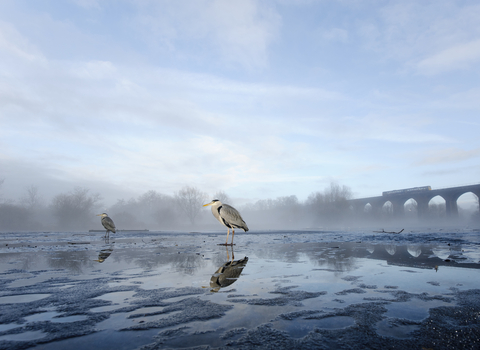
© Terry Whittaker/2020VISION
Where to encounter a heronry
Herons
The sight of a grey heron continuing in solitary siege on rivers and waterways is one that is equally familiar equally information technology is bewitching. Yet for around three months of the year from February these distinctive-looking birds, with their crests, dagger bills and stilt-similar legs come together to breed. A heronry is somewhere herons have nested for many generations and on sure Wildlife Trust reserves it'due south possible to catch a rare glimpse of upward to 40 nests teetering in the tree-tops at whatsoever one time.
With their heads drawn back and feet trailing behind, a heron almost unfurls itself into the air with its huge wings forming a curved m-shape
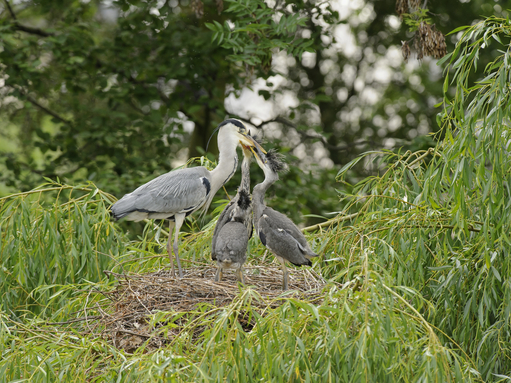
© Terry Whittaker/2020VISION
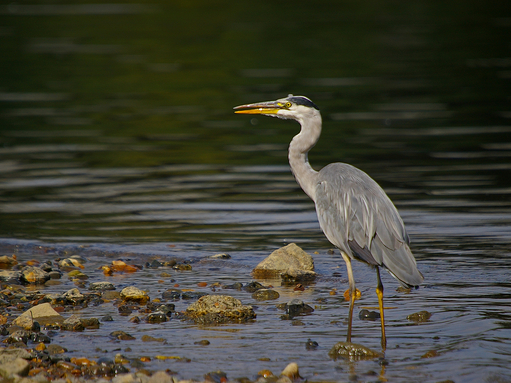
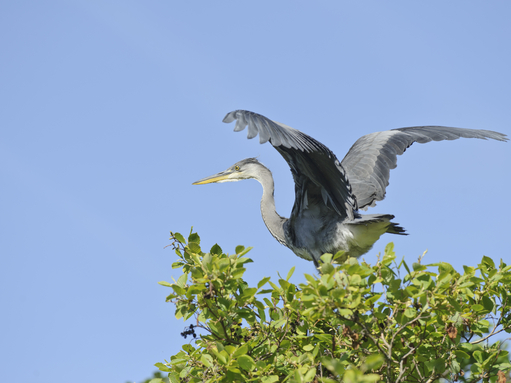
Juvenile grey heron - © Terry Whittaker/2020VISION
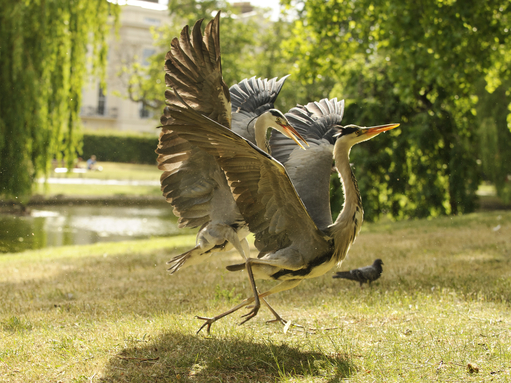
Adult herons fighting - © Terry Whittaker/2020VISION
Find a heronry near y'all
Do a little research in advance and notice out where your nearest heronry is. Here are x of the best Wild fauna Trust heronry sites from beyond the country:
Cleeve Heronry (Avon Wild animals Trust)
Cleeve Heronry - Domicile to one of the largest heronries in the southwest, more forty nests rest on the tops of oak and ash copse. Although admission is past permit only, a nearby lay-by offers the perfect opportunity to watch adult herons fly back and along to their Somerset angling grounds to gather food for their young. Cleeve garden centre is adjacent to the reserve, which has a tea shop with a photographic camera-feed to a nest-summit webcam.
Titchmarsh (The Wildlife Trust for Beds, Cambs and Northants)
Titchmarsh -The enchanting Titchmarsh wetland is well-worth visiting to take hold of a glimpse of the heronry located in the reserve's pines. Come forth in February to hear the noisy breeding calls of the herons and visit the reserve's grasslands to hear the chattering of breeding ground nesters including snipe, reed warbler and sedge warbler.
Trentabank Reservoir (Cheshire Wildlife Trust)
Trentabank Reservoir- The heronry at Trentabank Reservoir is one of the largest in the Peak District and sits inside the picturesque Macclesfield Forest. More than 20 pairs of the birds nest amongst the larches toward the eastern cease of the reservoir, which in winter is also regularly home to goldeneye and goosander. The surrounding woods also plays host to a secretive herd of red deer, while crossbills feed in the pino tops and peregrines, buzzards and even the occasional ruby-red kite patrol the skies in a higher place. The heronry is best viewed from the lay-by east of the ranger station and car park, while views of the reservoir tin can be enjoyed from the small circular path of the main Trust reserve. In some years, video footage from the heronry is also beamed to the ranger station when open up to visitors.
Dunsdon (Devon Wildlife Trust)
Dunsdon - Arguably the most important Culm grassland left in England, Dunsdon Nature Reserve represents a habitat in sharp decline. The marshy, heath-like grassland supports diverse wildlife including an agile heronry. Situated in the trees near the old Bude Canal, herons can be observed angling. Barn owls also frequently use the site as a feeding ground and may be seen roosting in the copse.
Stocker's Lake (Herts & Middlesex Wildlife Trust)
Stocker'southward Lake - 1 of the oldest gravel pits in the Colne Valley, Stocker's Lake is dwelling house to the county's largest heronry. Over 60 species of breeding birds have been recorded with the shoveler and golden eye being mutual visitors.
Besthorpe Nature Reserve (Nottinghamshire Wild fauna Trust)
Besthorpe Nature Reserve is comprised of three distinct habitat types: open water with islands, reedbeds and shingle – the perfect combination to support one of the largest heronries in Nottinghamshire.
For many years, young herons have been counted and ringed at Besthorpe and it was due to such efforts that a decline in the region's heron chicks was noted. Defended work by the Northward Nottinghamshire Ringing Group and support past the Surround Agency identified that local pollution was causing the chicks' bones to go brittle, endangering their chances of survival. Pollution in the region has at present been eliminated, while monitoring of the heron chicks is still ongoing. Plenty of hides are located around the southern area where herons tin can exist spotted visiting the pool for fish.
Attenborough Nature Reserve (Nottinghamshire Wildlife Trust)
The 145 hectare Attenborough Nature Reserve'due south flooded gravel pits and islands provide the platonic habitat to support the region'south largest heronry. Known as the Attenborough heronry, the first nest was recorded in 2007, which over the years, has increased to an impressive 40 nests. Around thirty of these tin be hands spotted around Tween Pond.
The Nottinghamshire Wildlife Trust has been responsible for monitoring heron numbers through the Heronries Census at the Attenborough reserve – a valuable indicator of the quality of the wetland habitat. The reserve is also an of import site for winter wildfowl and often holds a loftier proportion of the county'south shoveler and diving ducks including mallard and teal.
Ellesmere (Shropshire Wildlife Trust)
1 of the easiest heronries to get to and view in the UK can be found in Ellesmere, Shropshire, where nesting herons return each twelvemonth to Moscow Island. Using the bogus island built in the early on 19th Century to raise their immature, the heronry is growing in numbers.
Popular into the Ellesmere Shropshire Wildlife Trust visitor centre to watch the live camera feed. Herons gathering and delivering nesting material tin be seen in February, while come May, watch the herons lay their first eggs.
Coed Llwyn Rhyddid (The Wildlife Trust for South & West Wales)
Coed Llwyn Rhyddid is a mixed woodland made upward of oak, ash, beech and a mixture of conifers and boasts the third largest heronry in Wales. The herons tin exist seen arriving to their nests equally early as January, with skilful views from the roadside parking near the farm entrance track. Visit in July to scout the chicks fledge, while adult herons will often stay until belatedly Baronial. The reserve's warden frequently runs heron watching trips and viewings of the heronry tin be made on request (01656 724100) r.parry@welshwildlife.org - Viewings accept place from neighbouring land so permission needs to be bundled beforehand.
Ballynahone Bog (Ulster Wildlife Trust)
Located south of Maghera, Ballynahone Bog is the largest of Ulster Wildlife Trust'due south nature reserves and has an incredible range of bog flora, including nationally rare sphagnum mosses, liverworts and bog rosemary. The reserve'south heronry can be found in the bog's surrounding birch woodland. The biggest known colony of the large heath butterfly in Northern Republic of ireland is too found here.
What to expect for
The striking advent of the grey heron is not hands mistaken. Heronries, as well equally offering a take chances to see nesting behaviour, are also first-class places to spotter herons fly. Listen out as well for its distinctive kronking bark. Generally arriving in Feb, herons often lay their eggs in the same nests each yr, hatching between March and April. For your best gamble of spotting a nestling, visit in April when nests are usually still visible before they are obscured by tree leaves.
If you can't become to a heronry
If yous can't get to a heronry, it's still worthwhile looking out for herons hunting well-nigh you. Herons can be plant across the United kingdom of great britain and northern ireland, from urban and suburban habitats to the countryside and coast. A voracious feeder on fish, they besides will take ducklings, pocket-sized mammals like voles and amphibians. Look out for herons hunting in fields too, where after harvest time, they tin can be seen watching and waiting for rodents.
More wildlife experiences
From seeing colourful wildflowers to spotting magnificent birds of prey, we can help you lot become closer to wild fauna beyond the Britain.
Source: https://www.wildlifetrusts.org/where_to_see_a_heronry
0 Response to "A Heron Family Forest Grew in Manchester Usa"
Post a Comment